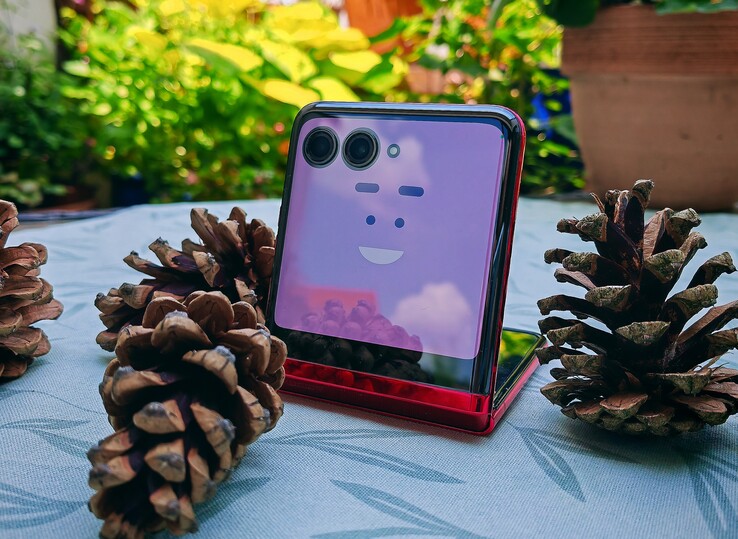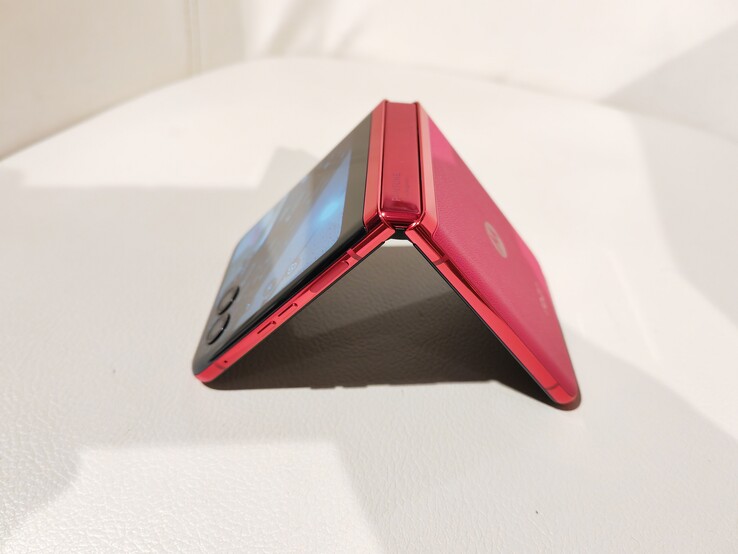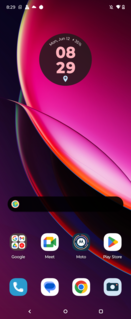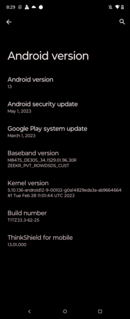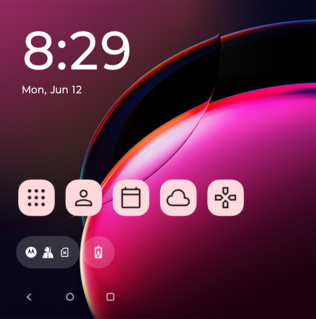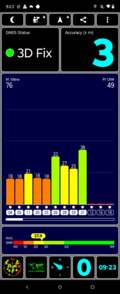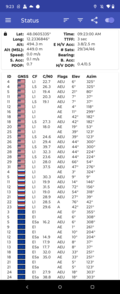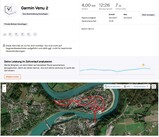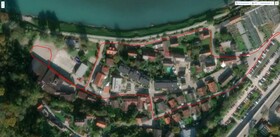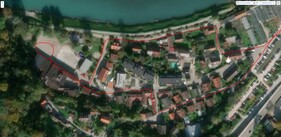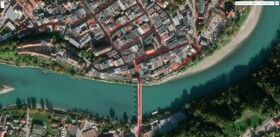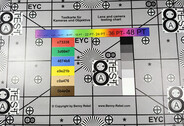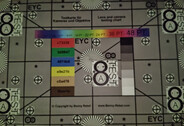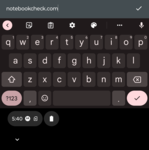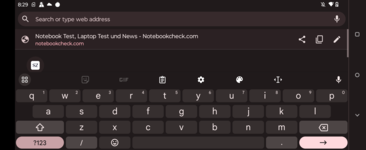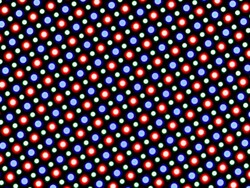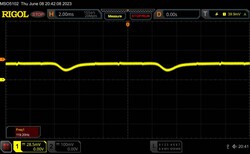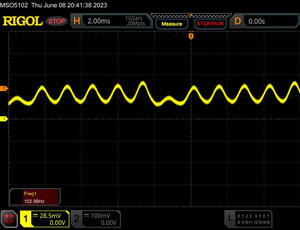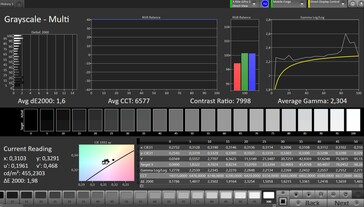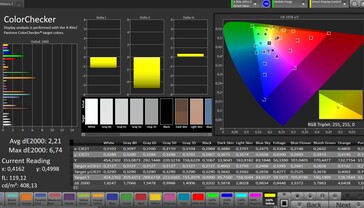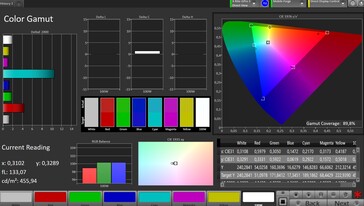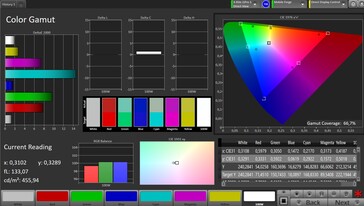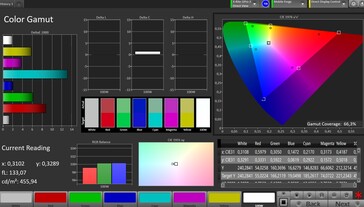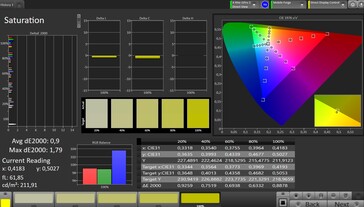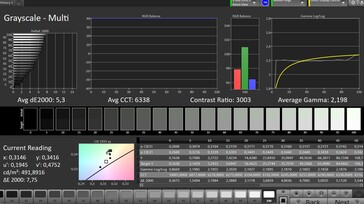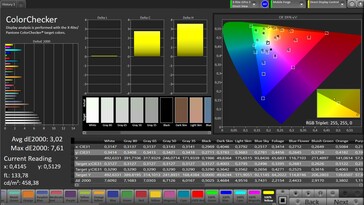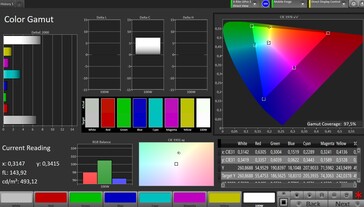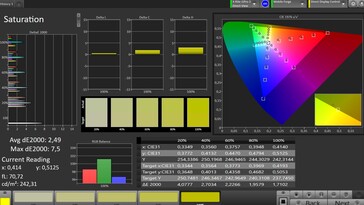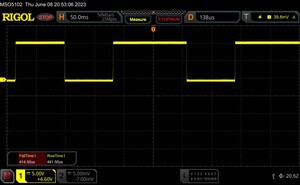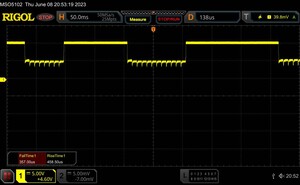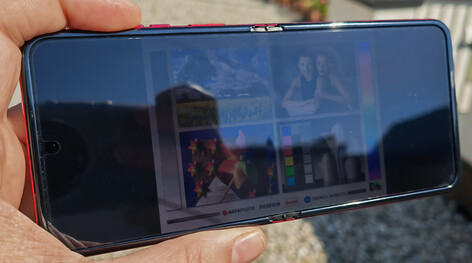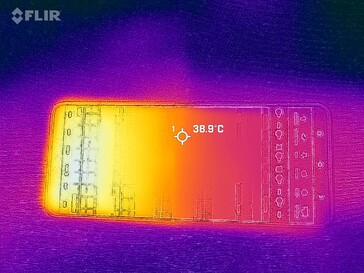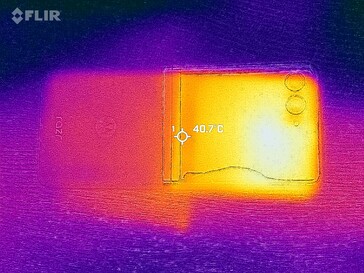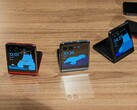Motorola Razr+ smartphone review – The high-end foldable that charges wirelessly
At $1,200, the Motorola Razr+ is no cheap smartphone, but it is a special one: You can fold it open along its short edge, just as you would have the legendary Razr flip phones of the 2000s. The result is a 6.9-inch screen that is about the same size as your usual phones. If you fold it shut, then you still have access to a 3.6-inch display and can neatly tuck the foldable away in your pocket.
In countries outside of the US, the Razr+ is sold under the name Motorola Razr 40 Ultra.
Motorola are looking to attract a stylish audience through their multiple collaborations and color variant offerings. Its wireless charging capabilities and eSIM support make this phone a well-rounded concept. So, is this a smartphone that will make everyone happy? Let's find out.
possible competitors compared
Rating | Date | Model | Weight | Drive | Size | Resolution | Price |
|---|---|---|---|---|---|---|---|
| 87 % v7 (old) | 06 / 2023 | Motorola Razr 40 Ultra SD 8+ Gen 1, Adreno 730 | 188.5 g | 256 GB UFS 3.1 Flash | 6.90" | 2640x1080 | |
| 87 % v7 (old) | 01 / 2023 | Motorola Razr 2022 SD 8+ Gen 1, Adreno 730 | 200 g | 256 GB UFS 3.1 Flash | 6.70" | 2400x1080 | |
| 87.2 % v7 (old) | 03 / 2023 | Honor Magic Vs SD 8+ Gen 1, Adreno 730 | 261 g | 512 GB UFS 3.1 Flash | 7.90" | 2272x1984 | |
| 87.9 % v7 (old) | 10 / 2022 | Samsung Galaxy Z Flip4 5G SD 8+ Gen 1, Adreno 730 | 187 g | 128 GB UFS 3.1 Flash | 6.70" | 2640x1080 | |
| 86.3 % v7 (old) | 12 / 2022 | Xiaomi Mix Fold 2 SD 8+ Gen 1, Adreno 730 | 262 g | 256 GB UFS 3.1 Flash | 8.02" | 2160x1914 |
Case – A slim, water-resistant aluminum case
The case on the Razr+ is a great success: The phone sits in your pocket much more neatly than older devices, as it now only has a thickness of 1.5 centimeters when it is folded together. And still, it remains stable when it is open and the phone's hinge becomes almost invisible. There is still quite a noticeable crease along the center of the device - but not nearly as bad as older models.
The phone comes in black and light blue and both variants have a matte glass back.
If you're looking for something a little more extra, you can also get the phone in the color Viva Magenta, which is the color of our test device. Its mix between light red and pink is a collaboration with the color experts of Pantone: Viva Magenta is the color of the year for 2023. Only this variation of the phone has a back made of faux leather.
The Razr+ is only water and dust proof to a limited extent: The phone has an IP52 certification. So still decent protection against dirt and water droplets. Weighing in at 188.5 grams, the foldable is really quite lightweight.
A quirky design feature: The Razr+ has its very own distinct scent, which Motorola have developed in collaboration with the olfactory experts of Firmenich. In our opinion, the scent doesn't have a very high-quality characteristic - if anything, it smells a bit like cheap shower gel. But regardless, it's a matter of personal taste anyway.
Features – The usual storage size and eSIM
For current foldables, 256 GB UFS 3.1 storage and 8 GB RAM are pretty standard. At the same time, you can often find phones with more or faster storage for a price of $1,200.
The phone doesn't feature a microSD card slot and it can only accommodate one Nano SIM. If you would like to use Dual-SIM, you still have the option to create an eSIM profile.
Software – Pure Android 13 with three promised updates
The Motorola phone comes delivered with Android 13 and the manufacturer has promised three big version updates and four years of regular safety patches. We contacted Motorola regarding other manufacturer's abilities to release patches more promptly - we were told that they are currently working on improving this situation. On a positive note: At the time of testing, the latest security patch was from May 2023, meaning it was up-to-date.
As always, Motorola have made sure to install a relatively pure version of Android and have only included a few of their own apps that offer features such as expanded gesture controls. The manufacturer has also adopted quite a few of the safety functions from ThinkShield for Mobile, which can be found on the ThinkPhone. The Moto Secure app lets you block unsafe WLAN connections and create specially protected folders.
Ready For is also available on the Razr+, which lets you easily connect the phone to your PC wirelessly. You can then use your phone as a second screen or a webcam, and you can also easily send files via a shared clipboard.
Communication and GNSS – No WiFi 7
The Motorola Razr+ utilizes WiFi 6E, which means the phone can use the lesser occupied 6 GHz band. The phone unfortunately hasn't yet mastered the cutting-edge WiFi 7. The full extent of its WLAN signal is available within close proximity of the router - ten meters away with three walls in between, the signal strength becomes a little weaker. Loading pages on the internet still seems to work super-fast, though.
Its speed is on quite a good level, with a maximum of 1.3 Gbit/s. Although, the phone's predecessor was cable of achieving slightly better values and in our test, the Razr+ appeared to be quite erratic at times - at least when it came to speeds.
Thanks to the many 4G and 5G bands supported by the phone, you can use it pretty much anywhere on the globe. In our test, the phone's mobile signal was great - about on the same level as other high-end smartphones.
| Networking | |
| iperf3 receive AXE11000 | |
| Honor Magic Vs | |
| Samsung Galaxy Z Flip4 5G | |
| Xiaomi Mix Fold 2 | |
| Average of class Smartphone (52 - 1721, n=179, last 2 years) | |
| iperf3 transmit AXE11000 | |
| Honor Magic Vs | |
| Samsung Galaxy Z Flip4 5G | |
| Xiaomi Mix Fold 2 | |
| Average of class Smartphone (49.8 - 1828, n=179, last 2 years) | |
| iperf3 transmit AXE11000 6GHz | |
| Motorola Razr 2022 | |
| Motorola Razr 40 Ultra | |
| Average of class Smartphone (508 - 1945, n=96, last 2 years) | |
| iperf3 receive AXE11000 6GHz | |
| Average of class Smartphone (451 - 1870, n=96, last 2 years) | |
| Motorola Razr 2022 | |
| Motorola Razr 40 Ultra | |
If you take the foldable smartphone outside, its position is quickly determined within about 3 meters. Many satellite networks are used in order for the phone to be able to do this, but unfortunately, it isn't able to utilize SBAS for even more accurate locating.
We jumped onto our bikes so we were able to gather some practical experiences using the Razr+'s positioning functions - we used a Garmin Venu 2 smartwatch as a comparison device. The smartphone seemed to show quite accurate locations - only sometimes did it deviate a little from our exact route. If you don't need to rely on super precise location determination, then the Razr+ is absolutely sufficient for navigating in everyday use.
Phoning functions and call quality – slightly muffled microphone
The Razr+ uses the standard Google telephone app and it supports both VoLTE and VoWiFi.
Callers' voices could be heard quite clearly through the phone's earpiece, although when we spoke through the device's microphone, it tended to sound a little muffled at times. You also have to make sure not to talk too quietly. The built-in speaker's maximum volume is only just loud enough but you can still understand the person you are speaking to quite well. Here, we also had to make sure to speak loud enough in order to guarantee that our voice was transmitted clearly.
Cameras – Decent image quality in good lighting conditions
Design-wise, Motorola have set out to make sure that the cover screen isn't ruined by having two differently sized cameras placed on top of it. So instead, two lenses which are the exact same size occupy the top left portion of the device: One is a 12-megapixel main camera with optical image stabilization, the other is 13-megapixel ultra-wide angle lens which can also be used as a macro camera.
The main camera takes nice, saturated pictures - although with a relatively cool white balance. When it comes to smaller details, the iPhone 14 and Honor Magic4 Pro's cameras offer just a little more. Images taken on the Apple smartphone tend to look a little more vivid, as they have stronger levels of contrast.
Due to a missing periscope zoom, the Razr+ remains a little less flexible in its photographing abilities. In low light conditions, darker areas could do with being lightened a little more - but all-in-all, the photos are quite sharp.
The wide-angle lens generally does its job well and smaller, individual details remain clear.
Videos can be recorded in a maximum of 4K and at 30 fps - here, quite a few other high-end phones have already started offering more, including video recording in 8K and at 60 fps.
Thanks to its outer screen, you can choose which camera you would like to take selfies on. There is also a generous 32-megapixel punch hole camera situated on the inside display - but it unfortunately isn't all too light sensitive. Generally on these types of cameras, 4 pixels are combined using pixel binning, which results in 8-megapixel images with better lighting levels.
Selfies taken in this way barely look any less high-quality than the ones taken on the phone's main camera.
Image comparison
Choose a scene and navigate within the first image. One click changes the position on touchscreens. One click on the zoomed-in image opens the original in a new window. The first image shows the scaled photograph of the test device.
Main camera flowerMain camera surroundingsMain camera low lightWide-angleIn the fully lit studio, the main camera delivered very sharp photos which managed to depict even the smallest of details. With a lighting strength of only 1 lux, the picture quality began to sank considerably - here, images didn't show very much detail or have good levels of contrast.
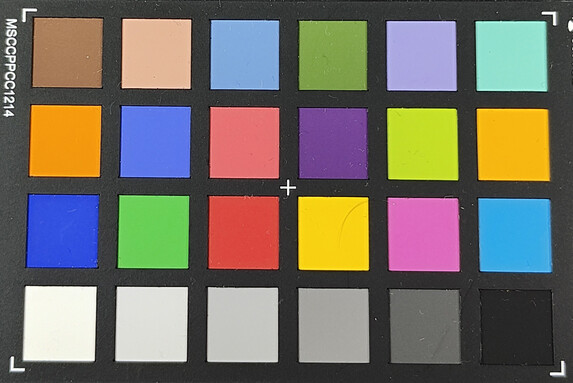
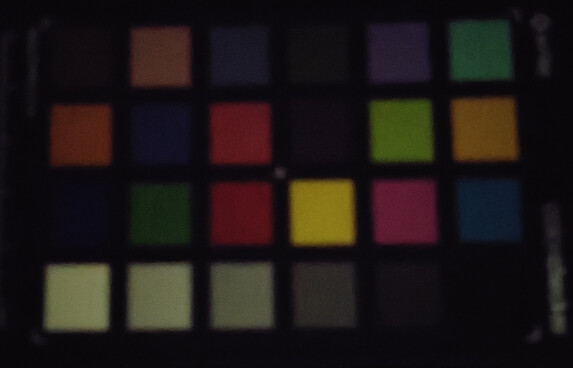
Accessories and warranty – A silicone cover is included
The phone comes with a 30-watt charger, a USB cable, a SIM tool and a two-part silicone case which protects both outer parts of the smartphone and is even color-coordinated.
Via Motorola's website, you can find a matching car charger for around $25 - a replacement charger costs around $22.
The manufacturer offers a standard 12-month warranty for devices purchased in the US which can be extended by an extra 12 months through their MotoCare service. There is also an option for extra protection against accidents - the best plan which includes 3 years of accident cover can cost up to $300.
Input devices & operation – The Moto phone with a quick touchscreen
The phone's main screen adapts its refresh rate dynamically between 1 and 165 Hz, which allows you to navigate the system smoothly and saves energy when viewing static images. You can also get fast refresh rates of up to 144 Hz on the cover display.
Both displays can be operated quickly thanks to their 360-Hz touchscreen sampling and are both sensitive right up to the corners. Apps that are run on the outer display are seamlessly transitioned to the inner display once the Razr+ is opened. This works the other way around as well - here, you just have to tap a button on the phone noting that you would like to continue using the app on the cover screen instead of putting the phone into standby mode.
A nice feature is that the hinge is able to hold the phone in virtuality any position - meaning the Razr+ basically has a built-in tripod: You can set it up in tent mode in order to watch a film on the outer display, or you can use both screens as viewfinders for the cameras. At the same time, the smartphone can also be used half opened to give you better stabilization - like a camcorder, basically.
In turn, the tight hinge does mean that the phone isn't very easy to fold open using one hand.
Display – Two high-quality OLED screens
The foldable main display has a diameter of 6.9 inches and with a ratio of 22:9, it is a little longer and narrower than your usual smartphone screen - in everyday use, this shouldn't be an issue. With a resolution of 2,640 x 1,080, it is about the same as other comparable foldables. Contents are shown nice and detailed and the crease in the middle is only visible if there is any backlight - however, you can definitely feel it.
The screen is a P-OLED display, meaning that individual pixels can be switched off entirely. Theoretically - with the exception of ambient light and light leaking in from the side - this means that the phone should be able to depict black perfectly. This also means its contrast ratio should be incredible, making colors glow nice and bright.
On the other hand, OLED screens don't have any form of backlighting which you would be able to dim, so most OLED phones turn to using PWM - this means the screen is switched off and on in very quick succession in order to make the screen appear dimmer. This can sometimes lead to some problems in light-sensitive people.
On the Razr+, we measured a relatively slow PWM frequency of 103 Hz, which could further exacerbate these problems. Motorola offer a mode called "Flicker Prevention", which reduces the signal considerably at lower brightness levels and corresponds with the refresh rate.
We would still recommend that light-sensitive people test out the screen in-store before committing to buying the phone.
| |||||||||||||||||||||||||
Brightness Distribution: 93 %
Center on Battery: 928 cd/m²
Contrast: ∞:1 (Black: 0 cd/m²)
ΔE ColorChecker Calman: 2.21 | ∀{0.5-29.43 Ø4.77}
ΔE Greyscale Calman: 1.6 | ∀{0.09-98 Ø5}
89.8% sRGB (Calman 2D)
Gamma: 2.304
CCT: 6577 K
| Motorola Razr 40 Ultra P-OLED, 2640x1080, 6.9" | Motorola Razr 2022 OLED, 2400x1080, 6.7" | Honor Magic Vs OLED, 2272x1984, 7.9" | Samsung Galaxy Z Flip4 5G Dynamic AMOLED , 2640x1080, 6.7" | Xiaomi Mix Fold 2 OLED, 2160x1914, 8" | |
|---|---|---|---|---|---|
| Screen | -21% | -27% | 17% | 6% | |
| Brightness middle (cd/m²) | 928 | 500 -46% | 803 -13% | 795 -14% | 1015 9% |
| Brightness (cd/m²) | 943 | 495 -48% | 809 -14% | 800 -15% | 1022 8% |
| Brightness Distribution (%) | 93 | 98 5% | 97 4% | 97 4% | 98 5% |
| Black Level * (cd/m²) | |||||
| Colorchecker dE 2000 * | 2.21 | 1.99 10% | 2.27 -3% | 1 55% | 1.6 28% |
| Colorchecker dE 2000 max. * | 6.74 | 5.37 20% | 5.99 11% | 2.5 63% | 3.4 50% |
| Greyscale dE 2000 * | 1.6 | 2.7 -69% | 3.9 -144% | 1.5 6% | 2.6 -63% |
| Gamma | 2.304 95% | 2.202 100% | 2.25 98% | 2.37 93% | 2.22 99% |
| CCT | 6577 99% | 6663 98% | 6234 104% | 6466 101% | 6506 100% |
* ... smaller is better
Screen Flickering / PWM (Pulse-Width Modulation)
| Screen flickering / PWM detected | 103 Hz | ||
The display backlight flickers at 103 Hz (worst case, e.g., utilizing PWM) . The frequency of 103 Hz is very low, so the flickering may cause eyestrain and headaches after extended use. In comparison: 53 % of all tested devices do not use PWM to dim the display. If PWM was detected, an average of 8083 (minimum: 5 - maximum: 343500) Hz was measured. | |||
Measurement series with fixed zoom level and different brightness settings
Using a spectrophotometer, we first measured the phone's maximum brightness with a fully white screen: The main display achieved a result of about 1,000 cd/m². At APL 18, so only 18 % of the screen being white, we measured results up to 1,100 cd/m². The Razr+'s outer screen is about 100 - 150 cd/m² less bright.
Then, we checked out the phone's color reproduction. The main screen showed minimal deviations compared to the color space's optimal values. We used the image mode "natural", which dampens bright colors ever so slightly. Brown tones deviated the most - and quite a few green tones, too. The cover screen was a little less accurate, but it can still depict colors well.
Display Response Times
| ↔ Response Time Black to White | ||
|---|---|---|
| 0.9 ms ... rise ↗ and fall ↘ combined | ↗ 0.4 ms rise | |
| ↘ 0.5 ms fall | ||
| The screen shows very fast response rates in our tests and should be very well suited for fast-paced gaming. In comparison, all tested devices range from 0.1 (minimum) to 240 (maximum) ms. » 2 % of all devices are better. This means that the measured response time is better than the average of all tested devices (20.2 ms). | ||
| ↔ Response Time 50% Grey to 80% Grey | ||
| 0.9 ms ... rise ↗ and fall ↘ combined | ↗ 0.4 ms rise | |
| ↘ 0.5 ms fall | ||
| The screen shows very fast response rates in our tests and should be very well suited for fast-paced gaming. In comparison, all tested devices range from 0.165 (minimum) to 636 (maximum) ms. » 3 % of all devices are better. This means that the measured response time is better than the average of all tested devices (31.6 ms). | ||
Performance – The Razr+ packs a punch
The Razr+'s Snapdragon 8+ Gen 1 from Qualcomm is a super-fast high-end SoC - not a current generation one, though. For most apps, it should offer more than enough power, as most programmers make sure to make their apps accessible on as many phones as possible.
According to the benchmarks, AI uses are not the Razr+'s strengths - clearly, the phone hasn't been optimized for this. Apart from that, it shows a little bit reduced performance compared to other smartphones and for this processor - but this is scrutinizing it on a high level.
| UL Procyon AI Inference for Android - Overall Score NNAPI | |
| Samsung Galaxy Z Flip4 5G | |
| Xiaomi Mix Fold 2 | |
| Average Qualcomm Snapdragon 8+ Gen 1 (3291 - 84787, n=21) | |
| Average of class Smartphone (3769 - 81594, n=133, last 2 years) | |
| Motorola Razr 40 Ultra | |
| Honor Magic Vs | |
| AImark - Score v3.x | |
| Average Qualcomm Snapdragon 8+ Gen 1 (887 - 147801, n=11) | |
| Average of class Smartphone (82 - 307528, n=120, last 2 years) | |
| Xiaomi Mix Fold 2 | |
| Honor Magic Vs | |
| Motorola Razr 40 Ultra | |
When it comes to graphics performance, our test device often fell behind compared to comparison devices which feature the same SoC. This might be due to its severe throttling under load - we will discuss this further in the "temperature" section of this review. Even so, it should still have enough graphics power to run pretty much any app without any issues.
GFXBench (DX / GLBenchmark) 2.7: T-Rex Onscreen | 1920x1080 T-Rex Offscreen
GFXBench 3.0: on screen Manhattan Onscreen OGL | 1920x1080 1080p Manhattan Offscreen
GFXBench 3.1: on screen Manhattan ES 3.1 Onscreen | 1920x1080 Manhattan ES 3.1 Offscreen
GFXBench: on screen Car Chase Onscreen | 1920x1080 Car Chase Offscreen | on screen Aztec Ruins High Tier Onscreen | 2560x1440 Aztec Ruins High Tier Offscreen | on screen Aztec Ruins Normal Tier Onscreen | 1920x1080 Aztec Ruins Normal Tier Offscreen | 3840x2160 4K Aztec Ruins High Tier Offscreen
| 3DMark / Wild Life Extreme Unlimited | |
| Samsung Galaxy Z Flip4 5G | |
| Motorola Razr 2022 | |
| Honor Magic Vs | |
| Xiaomi Mix Fold 2 | |
| Motorola Razr 40 Ultra | |
| 3DMark / Wild Life Extreme | |
| Samsung Galaxy Z Flip4 5G | |
| Motorola Razr 2022 | |
| Honor Magic Vs | |
| Xiaomi Mix Fold 2 | |
| Motorola Razr 40 Ultra | |
| 3DMark / Wild Life Unlimited Score | |
| Samsung Galaxy Z Flip4 5G | |
| Xiaomi Mix Fold 2 | |
| Motorola Razr 2022 | |
| Honor Magic Vs | |
| Motorola Razr 40 Ultra | |
| 3DMark / Wild Life Score | |
| Motorola Razr 40 Ultra | |
| Motorola Razr 2022 | |
| Honor Magic Vs | |
| GFXBench (DX / GLBenchmark) 2.7 / T-Rex Onscreen | |
| Motorola Razr 40 Ultra | |
| Xiaomi Mix Fold 2 | |
| Samsung Galaxy Z Flip4 5G | |
| Honor Magic Vs | |
| GFXBench (DX / GLBenchmark) 2.7 / T-Rex Offscreen | |
| Honor Magic Vs | |
| Xiaomi Mix Fold 2 | |
| Samsung Galaxy Z Flip4 5G | |
| Motorola Razr 40 Ultra | |
| GFXBench 3.0 / Manhattan Onscreen OGL | |
| Motorola Razr 40 Ultra | |
| Xiaomi Mix Fold 2 | |
| Samsung Galaxy Z Flip4 5G | |
| Honor Magic Vs | |
| GFXBench 3.0 / 1080p Manhattan Offscreen | |
| Honor Magic Vs | |
| Xiaomi Mix Fold 2 | |
| Motorola Razr 40 Ultra | |
| Samsung Galaxy Z Flip4 5G | |
| GFXBench 3.1 / Manhattan ES 3.1 Onscreen | |
| Motorola Razr 40 Ultra | |
| Samsung Galaxy Z Flip4 5G | |
| Xiaomi Mix Fold 2 | |
| Honor Magic Vs | |
| GFXBench 3.1 / Manhattan ES 3.1 Offscreen | |
| Honor Magic Vs | |
| Xiaomi Mix Fold 2 | |
| Motorola Razr 40 Ultra | |
| Samsung Galaxy Z Flip4 5G | |
| GFXBench / Car Chase Onscreen | |
| Motorola Razr 40 Ultra | |
| Honor Magic Vs | |
| Samsung Galaxy Z Flip4 5G | |
| Xiaomi Mix Fold 2 | |
| GFXBench / Car Chase Offscreen | |
| Honor Magic Vs | |
| Xiaomi Mix Fold 2 | |
| Motorola Razr 40 Ultra | |
| Samsung Galaxy Z Flip4 5G | |
| GFXBench / Aztec Ruins High Tier Onscreen | |
| Motorola Razr 2022 | |
| Samsung Galaxy Z Flip4 5G | |
| Motorola Razr 40 Ultra | |
| Honor Magic Vs | |
| Xiaomi Mix Fold 2 | |
| GFXBench / Aztec Ruins High Tier Offscreen | |
| Motorola Razr 40 Ultra | |
| Honor Magic Vs | |
| Xiaomi Mix Fold 2 | |
| Motorola Razr 2022 | |
| Samsung Galaxy Z Flip4 5G | |
| GFXBench / Aztec Ruins Normal Tier Onscreen | |
| Motorola Razr 2022 | |
| Motorola Razr 40 Ultra | |
| Samsung Galaxy Z Flip4 5G | |
| Honor Magic Vs | |
| Xiaomi Mix Fold 2 | |
| GFXBench / Aztec Ruins Normal Tier Offscreen | |
| Honor Magic Vs | |
| Xiaomi Mix Fold 2 | |
| Motorola Razr 40 Ultra | |
| Motorola Razr 2022 | |
| Samsung Galaxy Z Flip4 5G | |
| GFXBench / 4K Aztec Ruins High Tier Offscreen | |
| Motorola Razr 2022 | |
| Motorola Razr 40 Ultra | |
| Honor Magic Vs | |
| Samsung Galaxy Z Flip4 5G | |
| Xiaomi Mix Fold 2 | |
Internet pages are loaded quickly and images are usually already loaded when you scroll. In the browser benchmarks, the Razr+ performed consistently well.
| Jetstream 2 - 2.0 Total Score | |
| Average of class Smartphone (23.8 - 387, n=148, last 2 years) | |
| Samsung Galaxy Z Flip4 5G (Chrome 105) | |
| Average Qualcomm Snapdragon 8+ Gen 1 (76.2 - 204, n=23) | |
| Honor Magic Vs (Chrome 111) | |
| Motorola Razr 40 Ultra (Chrome 114) | |
| Xiaomi Mix Fold 2 (MiUI-Browser 14.7) | |
| Speedometer 2.0 - Result 2.0 | |
| Average of class Smartphone (15.2 - 643, n=120, last 2 years) | |
| Motorola Razr 40 Ultra (Chome 114) | |
| Average Qualcomm Snapdragon 8+ Gen 1 (69.1 - 196, n=18) | |
| Honor Magic Vs (Chome 111) | |
| WebXPRT 4 - Overall | |
| Average of class Smartphone (27 - 306, n=144, last 2 years) | |
| Samsung Galaxy Z Flip4 5G (chrome 105) | |
| Average Qualcomm Snapdragon 8+ Gen 1 (69 - 159, n=21) | |
| Motorola Razr 40 Ultra (Chrome 114) | |
| Honor Magic Vs (Chrome 111) | |
| Xiaomi Mix Fold 2 | |
| WebXPRT 3 - Overall | |
| Average of class Smartphone (38 - 380, n=30, last 2 years) | |
| Average Qualcomm Snapdragon 8+ Gen 1 (106 - 224, n=14) | |
| Motorola Razr 40 Ultra (Chrome 114) | |
| Honor Magic Vs (Chrome 111) | |
| Octane V2 - Total Score | |
| Samsung Galaxy Z Flip4 5G (Chrome 105) | |
| Average of class Smartphone (2228 - 126661, n=195, last 2 years) | |
| Average Qualcomm Snapdragon 8+ Gen 1 (17622 - 61536, n=24) | |
| Motorola Razr 40 Ultra (Chrome 114) | |
| Honor Magic Vs (Chrome 111) | |
| Xiaomi Mix Fold 2 (MiUI-Browser 14.7) | |
| Motorola Razr 2022 (Chrome 108) | |
| Mozilla Kraken 1.1 - Total | |
| Xiaomi Mix Fold 2 (MiUI-Browser 14.7) | |
| Average of class Smartphone (257 - 28190, n=155, last 2 years) | |
| Honor Magic Vs (Chrome 111) | |
| Average Qualcomm Snapdragon 8+ Gen 1 (665 - 1707, n=22) | |
| Motorola Razr 40 Ultra (Chrome 114) | |
| Samsung Galaxy Z Flip4 5G (Chrome 105) | |
* ... smaller is better
UFS 3.1 memory is fast - but not quite top-of-the-range anymore. However, due to foldable smartphones' complex build, manufacturers often have to try to save some costs somewhere, meaning that this is pretty standard for this type of phone and should in no way slow down the system.
| Motorola Razr 40 Ultra | Motorola Razr 2022 | Honor Magic Vs | Samsung Galaxy Z Flip4 5G | Xiaomi Mix Fold 2 | Average 256 GB UFS 3.1 Flash | Average of class Smartphone | |
|---|---|---|---|---|---|---|---|
| AndroBench 3-5 | -15% | -18% | -26% | 7% | -17% | 4% | |
| Sequential Read 256KB (MB/s) | 1816.8 | 1768 -3% | 1695.2 -7% | 1598.77 -12% | 1882.11 4% | 1757 ? -3% | 2240 ? 23% |
| Sequential Write 256KB (MB/s) | 1352.6 | 1149 -15% | 1296.5 -4% | 987.09 -27% | 1783.27 32% | 1204 ? -11% | 1877 ? 39% |
| Random Read 4KB (MB/s) | 362 | 315 -13% | 270.2 -25% | 308.23 -15% | 342.67 -5% | 287 ? -21% | 298 ? -18% |
| Random Write 4KB (MB/s) | 472.3 | 332 -30% | 300.1 -36% | 245.94 -48% | 446.48 -5% | 318 ? -33% | 345 ? -27% |
Games – You can expect 60 fps
Gaming on the Razr+ proves to be no problem - the screen can show up to 165 fps, after all.
However, you will also have to find a game which is optimized for this - most games will likely only be playable at 60 fps, for example, PUBG Mobile or Diablo Immortal. We measured the achievable frame rates using software from GameBench.
It wasn't always possible to run games at 60 fps - we could only run PUBG Mobile at 40 fps in Ultra HD. There are surely better-optimized phones on the market, but gaming on the Razr+ is still a fun and enjoyable experience for the average gamer.
Certain simpler games can even be played on the phone's cover screen.
Emissions – The Razr+ gets hot and bothered
Temperature
The Motorola Razr+ has to make do with sharing a relatively slim case with a Snapdragon 8+ Gen 1, which is famous for its high temperatures under full load. The case's temperatures make this fact quickly known - during particularly long and intense computing processes, temperatures can rise up to 54.6 °C (130.28 °F).
Although you will be unlikely to encounter these extremely high temperatures during everyday use, the 3DMark stress test showed us what they can cause: Only 44 % of the phone's initial performance remained after 20 runs of this benchmark. This means the CPU can be classed as a mid-range model after prolonged high-intensity computing - at least when it comes to performance.
(-) The maximum temperature on the upper side is 54.6 °C / 130 F, compared to the average of 35.2 °C / 95 F, ranging from 21.9 to 247 °C for the class Smartphone.
(-) The bottom heats up to a maximum of 48 °C / 118 F, compared to the average of 34 °C / 93 F
(+) In idle usage, the average temperature for the upper side is 25.8 °C / 78 F, compared to the device average of 32.9 °C / 91 F.
3DMark Wild Life Stress Test
| 3DMark | |
| Wild Life Stress Test Stability | |
| Honor Magic Vs | |
| Motorola Razr 40 Ultra | |
| Motorola Razr 2022 | |
| Samsung Galaxy Z Flip4 5G | |
| Wild Life Extreme Stress Test | |
| Xiaomi Mix Fold 2 | |
| Honor Magic Vs | |
| Samsung Galaxy Z Flip4 5G | |
| Motorola Razr 40 Ultra | |
Speakers
The Razr+ uses its earpiece as a second speaker, which can help produce a stereo effect. Although, only 80 dB(A) could be achieved together with the speaker on the bottom of the phone - not a particularly impressive result. So, although the phone can't get super loud, it can at least produce a clear sound with decent low mids.
Depending on the singer's voice, some music can still end up sounding a little uncomfortably shrill at full volume.
You can connect external audio devices via USB-C or Bluetooth. All the Bluetooth codecs you could possibly wish for (maybe apart from Samsung's Scalable Codec) are available, whether it's aptX (HD, Adaptive, TWS+), SBC, AAC, LHDC v4, LC3 or LDAC you are looking for.
Motorola Razr 40 Ultra audio analysis
(±) | speaker loudness is average but good (79.7 dB)
Bass 100 - 315 Hz
(-) | nearly no bass - on average 20.2% lower than median
(±) | linearity of bass is average (9.8% delta to prev. frequency)
Mids 400 - 2000 Hz
(+) | balanced mids - only 4.4% away from median
(+) | mids are linear (3.9% delta to prev. frequency)
Highs 2 - 16 kHz
(+) | balanced highs - only 3.7% away from median
(+) | highs are linear (6% delta to prev. frequency)
Overall 100 - 16.000 Hz
(±) | linearity of overall sound is average (17.8% difference to median)
Compared to same class
» 14% of all tested devices in this class were better, 9% similar, 77% worse
» The best had a delta of 11%, average was 35%, worst was 134%
Compared to all devices tested
» 35% of all tested devices were better, 8% similar, 57% worse
» The best had a delta of 4%, average was 24%, worst was 134%
Samsung Galaxy Z Flip4 5G audio analysis
(+) | speakers can play relatively loud (86.3 dB)
Bass 100 - 315 Hz
(-) | nearly no bass - on average 22.7% lower than median
(±) | linearity of bass is average (11.6% delta to prev. frequency)
Mids 400 - 2000 Hz
(+) | balanced mids - only 3.7% away from median
(+) | mids are linear (3.4% delta to prev. frequency)
Highs 2 - 16 kHz
(±) | higher highs - on average 6.1% higher than median
(+) | highs are linear (2.5% delta to prev. frequency)
Overall 100 - 16.000 Hz
(±) | linearity of overall sound is average (17.4% difference to median)
Compared to same class
» 12% of all tested devices in this class were better, 8% similar, 80% worse
» The best had a delta of 11%, average was 35%, worst was 134%
Compared to all devices tested
» 32% of all tested devices were better, 8% similar, 59% worse
» The best had a delta of 4%, average was 24%, worst was 134%
Battery life – Finally wireless charging
Power consumption
Under full load, the Motorola Razr+ isn't the most frugal device, measuring a consumption of up to 10.3 watts. On the other hand, it doesn't seem to consume much under minimal load. In total, the Razr+ left a mixed impression on us: It couldn't quite achieve the same results as the super-frugal Samsung Galaxy Z Flip4 5G, but there are definitely more power-hungry devices on the market, too.
You can charge the phone with a maximum of 33 watts using the supplied charger. As the phone's battery isn't the biggest, it only takes 1:10 h to reach a full charge. Finally, a Razr-series device which supports wireless charging: With up to 5 watts via the Qi standard.
| Off / Standby | |
| Idle | |
| Load |
|
Key:
min: | |
| Motorola Razr 40 Ultra 3800 mAh | Honor Magic Vs 5000 mAh | Samsung Galaxy Z Flip4 5G 3700 mAh | Xiaomi Mix Fold 2 4500 mAh | Average Qualcomm Snapdragon 8+ Gen 1 | Average of class Smartphone | |
|---|---|---|---|---|---|---|
| Power Consumption | -36% | 37% | 3% | -23% | -17% | |
| Idle Minimum * (Watt) | 0.9 | 1.3 -44% | 0.56 38% | 0.97 -8% | 1.006 ? -12% | 0.847 ? 6% |
| Idle Average * (Watt) | 1.1 | 1.7 -55% | 0.71 35% | 1.37 -25% | 1.834 ? -67% | 1.446 ? -31% |
| Idle Maximum * (Watt) | 1.3 | 2 -54% | 0.79 39% | 1.48 -14% | 1.984 ? -53% | 1.63 ? -25% |
| Load Average * (Watt) | 5.5 | 7 -27% | 3.59 35% | 3.98 28% | 5.68 ? -3% | 6.95 ? -26% |
| Load Maximum * (Watt) | 10.3 | 10.1 2% | 6.45 37% | 6.83 34% | 8.44 ? 18% | 11.3 ? -10% |
* ... smaller is better
power consumption: Geekbench (150 cd/m²)
power consumption: GFXBench (150 cd/m²)
Runtimes
The Razr+ has a 3,800 mAh battery. This is 300 mAh more than its predecessor and slightly more than Samsung's Galaxy Z Flip4. Its runtimes are decent - but of course, they still can't keep up with conventional smartphones in any way.
If you'd like to surf the web using a relatively low screen brightness, then you can get 11:09 h out of the device. Under full load, the phone still manages 4:19 h. These are decent results for a foldable and should be more than sufficient for getting you through the day.
| Motorola Razr 40 Ultra 3800 mAh | Motorola Razr 2022 3500 mAh | Honor Magic Vs 5000 mAh | Samsung Galaxy Z Flip4 5G 3700 mAh | Xiaomi Mix Fold 2 4500 mAh | |
|---|---|---|---|---|---|
| Battery runtime | -16% | 7% | -2% | -15% | |
| Reader / Idle (h) | 23.7 | 23.9 1% | |||
| H.264 (h) | 16.9 | 18.2 8% | |||
| WiFi v1.3 (h) | 11.2 | 9.4 -16% | 12.6 13% | 11 -2% | 9.5 -15% |
| Load (h) | 4.3 | 4.5 5% |
Pros
Cons
Verdict – Stylish and well designed
With the release of the Razr+, Motorola have tackled many weaknesses of foldable phones head on - and have actually managed to keep them in check for the most part: Its hinge seems very stable, is almost invisible when the phone is open and now only causes a minor crease along the middle of the screen. At the same time, its case is kept quite slim, meaning the phone should be able to fit into your pockets easily - bringing along with it that familiar sense of nostalgia from the good old days of foldable phones.
The next model should really be a little easier to open - but for now, the tight hinge enables many different uses reminiscent of Lenovo's Yoga laptops.
The cover screen has grown considerably and can now be used in even more ways - although not all apps are compatible with it. The phone's notably bigger battery and wireless charging support round out its features well.
On the flip side (and taking into account the phone's complex construction), you can't help but notice that Motorola seem to be offering a little outdated hardware for the pricy sum of about $1,200: The cameras are still missing a periscope zoom for even more flexibility and the phone's video features are still suboptimal. Its processor is quick but is also last year's model - plus, it seems that cooling proves to be an issue in the Razr+'s slim case.
The Motorola Razr+ is a stylish foldable that overcomes the concept's past issues well in some areas. Its price, however, remains high.
After the launch of the Razr+, its predecessor - the Razr 2022 - has got a lot cheaper. Last year's model features the same SoC but a considerably smaller cover screen. If you still remain undecided, you might want to hold off until the release of the Galaxy Z Flip5, which - according to some rumors - is still to come this summer.
Price and availability
At the time of testing, the Motorola Razr+ is not yet available to purchase in the US. However, you can sign up on Motorola's website to be notified as soon as pre-orders begin.
Motorola Razr 40 Ultra
- 06/12/2023 v7 (old)
Florian Schmitt
Transparency
The selection of devices to be reviewed is made by our editorial team. The test sample was provided to the author as a loan by the manufacturer or retailer for the purpose of this review. The lender had no influence on this review, nor did the manufacturer receive a copy of this review before publication. There was no obligation to publish this review. As an independent media company, Notebookcheck is not subjected to the authority of manufacturers, retailers or publishers.
This is how Notebookcheck is testing
Every year, Notebookcheck independently reviews hundreds of laptops and smartphones using standardized procedures to ensure that all results are comparable. We have continuously developed our test methods for around 20 years and set industry standards in the process. In our test labs, high-quality measuring equipment is utilized by experienced technicians and editors. These tests involve a multi-stage validation process. Our complex rating system is based on hundreds of well-founded measurements and benchmarks, which maintains objectivity. Further information on our test methods can be found here.


